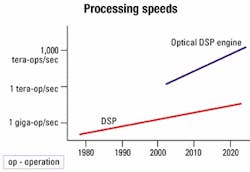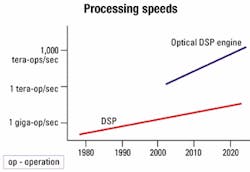Optical digital signal processing at the speed of light
While it's true that Lenslet Labs (Ramat-Gan, Israel) plans to focus its newly unveiled optical digital signal processing engine (ODSPE) technology on optical computing, it's not much of a reach to see that applications in the optical network could soon follow.
Lenslet announced that it is taking signal processing to the maximum transmission speed-the speed of light-by replacing traditional electronic silicon-based DSPs with ultra-fast and reconfigurable ODSPE. Using a proprietary optical core, the technology takes electronic digital input, converts it to photons, performs computation at light speed in the optical core, then converts optical output signals back into digital electronic form.
ODSPEs currently target any application requiring a large amount of computing power and very high level of parallelism, such as 3G cellular, broadband wireless access, xDSL, machine vision, and voice recognition. In these and similar applications, DSPs have not delivered the necessary performance, according to Lenslet. FPGAs and ASICS, used as high-end DSP engines, have picked up the slack, resulting in a loss of flexibility and reconfigurability of software-based solutions. In response, Lenslet designed its technology to provide the performance of hard-wired solutions with the flexibility of programmable devices.In its current form, Lenslet's ODSPE is a hybrid technology combining electro-optic engines and electronic interfaces. Using a proprietary technology for the conversion of electrical signals to optical signals, forward conversion (using a source array) can operate at the speed of 1 giga-vector/sec, while backconversion using a photodetector array operates at even higher speeds. The result is an increase in processing transforms by many orders of magnitude. In addition, the footprint is 10x8x1.7 cm.
While the performance of current DSPs is measured in hundreds and thousands of mega-operations per second (MOPS), Lenslet's single-component ODSPE reaches tera-operations per second (TOPS), with the potential of reaching hundreds of TOPS in the foreseeable future, according to the company.
Unlike DSPs, Lenslet uses mathematical transforms rather than instructions as a base, greatly accelerating software development time by mapping computation-intensive algorithms onto the ODSPE at conceptually higher levels of abstraction. By executing transforms in stead of multiply and accumulate (MAC) instructions, programmers no longer need to create algorithms for individual data points but instead work on problems at the higher level of mathematical transforms.
When asked what optical-network advantage would be gained by incorporating ODSPE, Avner Goren, vice president of marketing and business development at Lenslet, cites a few possibilities, including a major role for echo cancellation in future networks based on IP, for example, high-quality echo cancellation on many channels in parallel. "There may be applications we haven't seen yet," says Goren. "If you look at history, sometimes applications emerge only because suddenly there is a technology that can solve a problem cost-effectively. I'm not sure that we can forecast or even guess all of the different applications that may emerge as a result of our technology just because people have such a tool available to them. I think we'll be surprised."

